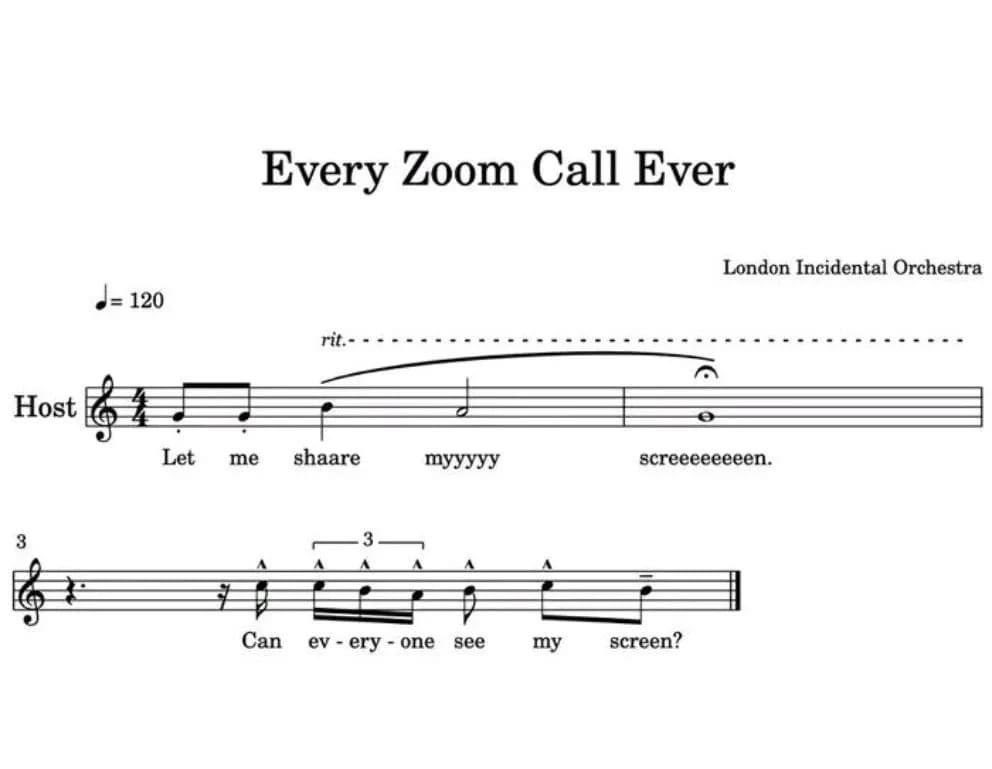Table of Contents
Pronunciation guides, or Where do you think I’m from?
Pronunciation guides, or Where do you think I’m from?
Slides available at http://anthro.rschram.org/3621/2024/2/slides
Main reading: Newman (2002)
Other reading: Ahearn (2021b); Ahearn (2021a); Blommaert (2009); Moore (2011); Silverstein (2022); Thorpe (2015)
What is this a picture of?
[Alt text: “A piece of sheet music titled “Every Zoom call ever.” The words under the notes read “Let me shaare myyyy screeeeeeen. Can everyone see my screen?”]
The study of language was part of the origin of anthropology
Boas conceived of anthropology as a field with four branches: biological (or physical) anthropology, archaeology, cultural anthropology, and linguistic anthropology. This is what it means to say that anthropology is the holistic study of humanity.
Boas’s contributions to the study of language
- The problem of alternating sounds (Boas 1889)
- The color of water (Boas 1881; Helmreich 2011; see also Krupnik and Müller-Wille 2010)
Structuralism and Chomskyian linguistics
Saussure says that we are asking the wrong questions
We should not ask
- How did we get the languages we have now?
- Why do people speak the ways they do?
We should ask
- Why is it possible to communicate in words at all? Why does any of this work?
For this reason he distinguishes langue and parole.
Saussure to define a study of language as an autonomous object, langue independent of parole. The same goal inspired many others to create a structuralist linguistics, culminating in the work of Noam Chomsky (Stanlaw 2020).
A language is also a spectrum of variations
- dialects
- registers
- bilingualism, contact languages
- code-switching
None of these bear on competence in a language according to Chomsky. They are all matters of performance, which is irrelevant to the study of the structural, generative rules of a language or the language faculty.
Dell Hymes rebuts the competence–performance distinction in defense of a study of language variation and an ethnographic study of language as it is used (Stanlaw 2020).
A new model of semiosis beyond structure
Charles Sanders Peirce (note correct spelling) is another piece of this puzzle.
All of these things have meaning and communicate something, but that can’t always be captured in a concept of a sign as composed of signifier and signified.
- smoke
- a photograph of a person
- an emoji, any of the emojis: 🤢🤮👺🤡🙈🍠🙃🪶🐶
- a footprint
- a detailed carving of the shape of the sole of a foot in moist soil
- a flag, of Australia or the US
- a flag, the yellow one with the snake on it (or the blue one with the white cross and stars in weird places)
References and further reading
Ahearn, Laura M. 2021a. Living Language: An Introduction to Linguistic Anthropology. Malden, Mass.: John Wiley & Sons. https://doi.org/10.1002/9781444340563.
———. 2021b. “The Socially Charged Life of Language.” In Living Language: An Introduction to Linguistic Anthropology, 3–30. Malden, Mass.: John Wiley & Sons. https://doi.org/10.1002/9781444340563.
Blommaert, Jan. 2009. “A Market of Accents.” Language Policy 8 (3): 243–59. https://doi.org/10.1007/s10993-009-9131-1.
Boas, Franz. 1881. “Beiträge Zur Erkenntnis Der Farbe Des Wasser.” Dissertation, University of Kiel.
———. 1889. “On Alternating Sounds.” American Anthropologist 2 (1): 47–54. http://www.jstor.org/stable/658803.
Gurvich, Rachel. 2022. “🎼 I Feel so Seeeeeen 🎵 Https://t.co/haZKCbCJrr.” Tweet. Twitter. https://twitter.com/RachelGurvich/status/1489743811773358085.
Helmreich, Stefan. 2011. “Nature/Culture/Seawater.” American Anthropologist 113 (1): 132–44. https://doi.org/10.1111/j.1548-1433.2010.01311.x.
Krupnik, Igor, and Ludger Müller-Wille. 2010. “Franz Boas and Inuktitut Terminology for Ice and Snow: From the Emergence of the Field to the ‘Great Eskimo Vocabulary Hoax’.” In SIKU: Knowing Our Ice: Documenting Inuit Sea Ice Knowledge and Use, edited by Igor Krupnik, Claudio Aporta, Shari Gearheard, Gita J. Laidler, and Lene Kielsen Holm, 377–400. Dordrecht: Springer Netherlands. https://doi.org/10.1007/978-90-481-8587-0_16.
Moore, Robert. 2011. “‘If I Actually Talked Like That, I’d Pull a Gun on Myself’: Accent, Avoidance, and Moral Panic in Irish English.” Anthropological Quarterly 84 (1): 41–64. https://www.jstor.org/stable/41237479.
Newman, Barry. 2002. “Accent.” The American Scholar 71 (2): 59–69. https://www.jstor.org/stable/41213291.
Silverstein, Michael. 2022. Language in Culture: Lectures on the Social Semiotics of Language. Cambridge: Cambridge University Press. https://doi.org/10.1017/9781009198813.
Stanlaw, James. 2020. “Chomsky, and the Chomskyan Tradition Vs. Linguistic Anthropology.” In The International Encyclopedia of Linguistic Anthropology, 1–14. John Wiley & Sons, Ltd. https://doi.org/10.1002/9781118786093.iela0049.
Thorpe, David. 2015. “Who Sounds Gay?” The New York Times, June 23, 2015, sec. Opinion: Op-docs. https://www.nytimes.com/video/opinion/100000003757238/who-sounds-gay.html.

